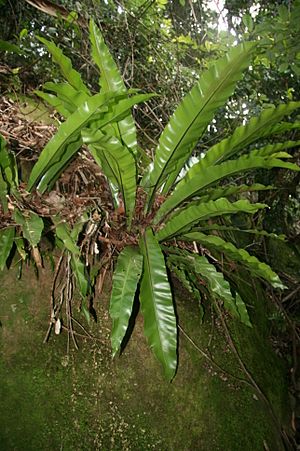Bird's nest fern facts for kids
Quick facts for kids Bird's nest fern |
|
|---|---|
 |
|
| Scientific classification | |
| Genus: |
Asplenium
|
| Species: |
australasicum
|
The bird's nest fern, also known as the crow's nest fern (Asplenium australasicum), is a type of fern. It grows on other plants, like trees, but it doesn't harm them. This fern is found in Australia and nearby islands. It belongs to the fern family called Aspleniaceae.
Contents
What's in a Name?
A botanist named John Smith first described this fern in 1857. He gave it the name Neottopteris australasica. Later, in 1859, another botanist named William Jackson Hooker gave it the scientific name we use today: Asplenium australasicum.
It can be a bit tricky to tell this fern apart from similar ones. For a long time, people confused it with a fern called Asplenium nidus. Scientists have also found that some ferns in Japan that looked like Asplenium australasicum are actually a different species, now called Asplenium setori.
What Does It Look Like?
The bird's nest fern grows in a bushy shape. Its leaves, called fronds, grow in a circle, looking like a bird's nest. These fronds are yellowish-green. They can be quite long, usually about 60 to 80 centimeters (24 to 32 inches). They are also fairly wide, from 3 to 21 centimeters (1.2 to 8.4 inches).
You can tell this fern apart from Asplenium nidus by looking at the underside of its fronds. The bird's nest fern has a clear, raised line down the middle of its fronds. This makes them look a bit like a boat's keel. The fern's spores, which are like tiny seeds, grow in lines on the underside of the fronds. These lines run parallel to the veins.
Where It Grows
Asplenium australasicum grows in eastern New South Wales and Queensland, Australia. It can grow on rocks or as an epiphyte on trees. This means it attaches itself to trees but gets its food from the air and rain, not from the tree itself.
These ferns can grow very large. The center of the fern can collect leaves and other plant bits. An old botanist once warned that sometimes a black snake might coil up in the middle of these ferns. So, be careful if you are looking for them!
Growing Your Own Fern
People started growing bird's nest ferns more often after they were collected from areas where trees were being cut down. This fern is quite easy to grow in gardens or pots. The most important thing is to make sure it has good drainage. If water sits around its roots, it can rot. You can grow it in a large pot or even a barrel.
Sometimes, tiny white insects called coconut scale might attack the underside of the fronds when the fern is grown in a garden.
How People Use It
Besides being a popular plant for gardens, the bird's nest fern is also eaten as a vegetable in Taiwan. Especially in the eastern part of the island, people eat the young, fresh fronds. They collect them from both wild and cultivated plants. These fronds are becoming more popular in other places too because of their nice texture and taste.

